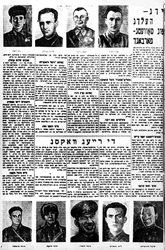|
Jews in the Red Army, 1941–1945
|
| Jews in the Red Army, 1941–1945 "Jews – Heroes of the Soviet Union" Jews were represented in significant numbers in many of the types of military units that operated in modern warfare – in tank forces, in the artillery, in the air force, and in the submarine fleet. Many Jews served in the ranks of military translators, physicians, military correspondents, and political officers who were attached to the various types of forces. Their noticeable presence in these military professions reflected the high educational level of Soviet Jews. However, the largest representation of Jews was in the 16th Lithuanian and the 201st (from October 1942 – 43rd) Latvian Infantry Divisions formed mainly from former residents of those republics; at certain times the percentage of Jews in those units reached 33 and 17 percent respectively. Nevertheless, initiatives to establish separate Jewish military formations did not yield any results – creation of Jewish units did not correspond to Soviet propaganda purposes of the war period. Jews also served in Cossack units, including as officers up to the rank of commanders of regiments. This situation challenged traditional views about permanently hostile relations between Jews and Cossacks. In 1943 and 1944 many Jewish partisans, as well as young Jews who had survived the Holocaust under false identification documents or in shelters, jointed the Red Army right after the liberation of Soviet territories. Among the Soviet troops were a relatively large number of Jewish women. The majority of them were doctors, nurses, or translators. Often Jewish women were among the medics who evacuated the wounded from the battlefield or served in other unites whose members were also often in battle zones. A special category was composed of those Jewish women who participated directly in combat – as pilots or navigators in the Soviet air force, or in artillery units. Many Jews were awarded government recognition for their military endeavors. According to official Soviet data, as of January 1944 more than 32,000 Jews received such awards. In that respects the Jews were fourth in the country, after the Russians, Ukrainians, and Belarusians although they were seventh in the USSR in terms of total population. The number of Jews who were awarded the title of Hero of the Soviet Union, the highest level of distinction, was over 100. However, this statistic is evidently understated since, for various reasons, Jews were sometimes listed on their identity papers as Ukrainians, Lithuanians, Tatars, etc. The very fact of the award, i.e., of official recognition of the military prowess of Jews was important for Soviet Jews, both at the front and in the rear. The poet Alexander Gitovich noted: "When I read the lists of those honored, I always look to see if there are any Jewish names and I am very happy when there are." Such knowledge helped Soviet Jews challenge antisemitism (that was increasing during the war among the people and members of the Soviet bureaucracy), which included the view that Jews were "bad soldiers." A particular role in circulating information about the participation of Jews in combat and about Jewish heroism was played by the Jewish Anti-Fascist Committee (JAC), which began operating in the spring of 1942. Approximately one third of all the publications prepared by or with the JAC dealt with Jews on the front lines. Some of them were published in the Committee's Yiddish newspaper Eynikayt, the first issue of which appeared in June 1942. Hundreds of other materials were sent to Jewish telegraphic agencies and Jewish newspapers abroad. These articles not only recounted the military exploits of Jews but often put the accounts into their more general ethnic context. The materials stressed the ethnic origin of the heroes and their following of the ancient Jewish heroic tradition, as embodied by Samson, the Macabbees, Bar Kochba etc. Many of the articles were intended to make the point that, in addition to the war they shared with the other Soviet peoples, Soviet Jews had their own war, their own score to settle with the Nazis. In 1942 the Soviet Yiddish prose writer Dovid Bergelson wrote that the Soviet Jews were fighting "Far zayn foterland un zayn yidishn folk," i.e., for their [Soviet] homeland and their Jewish people. As the details of the Nazi mass murder of Jewish civilians became increasing known during the war, the ethnic consciousness of a large proportion of Jewish soldiers and officers grew and increasingly motivated them in their fighting. The 100 accounts of Jews in the Red Army that are included in the present project highlight those who received formal recognition, primarily as Heroes of the Soviet Union, of their military achievements. However, there are also many biographies of those whose services did not receive such a high level of recognition. Among those included on our website are generals, officers, and privates; tank crew members, submariners, pilots, translators and doctors; men and women; very young people who had recently left their childhoods behind and middle-aged people. These people acted on different fronts: they defended Moscow, took part in the battle for Stalingrad, liberated Ukraine and Belorussia, fought against Axis troops in Lithuania, Latvia, Estonia, Poland, Romania, and Czechoslovakia, and participated in the capture of Berlin. The stories tell about their pre-war experience as members of the intelligentsia, professional military men, or factory workers and - for those who survived the war - about events of their post-war life. Such an approach allows us to better understand the effect the war had on Jewish Red Army personnel. Their biographies, included in the project in alphabetical order, often contain quotations from wartime articles and letters, as well as post-war memoirs. These texts cast light on the Jewish identity of these people and their reaction to the Holocaust. http://www.yadvashem.org/yv/en/about/institute/ppka_soldiers/about.asp
|
|
|
